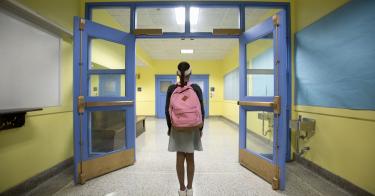George Floyd's tragic death prompted national protests against police brutality and then a chorus of calls to defund police departments. The movement swept up school district officials, some of whom are removing armed officers from public schools.
Yet it wasn't a gun that killed George Floyd. The video of his death lasted an excruciating 8 minutes and 46 seconds and is seared in the national consciousness.
But parents and educators would do well to recognize that the Floyd video was 6 minutes longer than it took Deputy Jimmy Long to stop a 19-year-old with a gun at a Marion County, Florida, school on April 20, 2018.
Earlier that year, on Feb. 14, a student gunman took the lives of 17 students and adults in Parkland, Florida. A "National School Walkout" to protest gun violence was organized to take place April 20, the anniversary of the Columbine High School massacre in which two students killed 13 people and wounded nearly two dozen others.
Just four hours north of Parkland, students at Forest High School were preparing to leave the building as part of the walkout when a gunshot rang out. A former student had entered the premises and shot a 17-year-old.
Deputy Long, a school resource officer, "ran towards where he thought the noise came from," said Sgt. Paul Bloom, director of public information for the Marion County Sherriff's Office. "That's what you train for and you hope you never have to deal with, but they (school resource officers) are there to protect the children."
Had Long not been on campus, April 20 might have marked another somber anniversary.
The Minneapolis school board has, for years, considered removing school resource officers from district schools. While unrelated to schools, Floyd's death prompted the board to officially sever ties with law enforcement last month. Portland, Oregon, schools followed. According to reports, school officials in California, Colorado, Illinois, Maryland, New York, North Carolina, Washington and Wisconsin are considering similar moves.
Floyd's death was brutal, but demands to remove school resource officers after this event suggest that police are the problem—a perspective that is easy to take until a troubled individual with a weapon walks into your child's classroom.
Over the last 25 years, the number of school resource officers in schools has nearly doubled, often with approval of school communities, according to surveys. A 2013 Congressional Research Office report found that, based on the research available, "the expansion of SRO programs coincided with a decrease in reported serious violent victimizations of students while at school and generally lower numbers of violent deaths and homicides at schools."
Cameras and smartphones are virtually everywhere, so videos of aggressive officers go viral quickly. Yet federal data show that some 1.4 million incidents involving criminal activity happen in schools every year, which means thousands of incidents that officers handled properly go without a headline for every problem with a school resource officer.
Parents and policymakers must still address the troubling examples of officers abusing their position, however, and after the Parkland shooting in 2018, state officials emphasized the training programs available to officers assigned to schools. The Federal Commission on School Safety, formed that year, heard copious testimony on the importance of such training.
The Commission's final report listed programs in Texas, South Dakota, Arkansas, Indiana, Virginia and Ohio, to name a few. Surveys of school resource officers—including a 2014 survey of Minnesota police—demonstrate that officers want this training, especially in the areas of counseling and mentoring students.
Lawmakers should be wary of federal proposals to standardize school resource officer responsibilities or evaluations, and families should object to across-the-board elimination of the officers from schools. Law enforcement agencies certainly have best practices to share, but the 2018 Federal Commission was correct to say "the problem of school violence is long-standing and complex" and there "can be no 'one-size-fits-all' approach."
Specific training can help, along with removing the comparatively few officers that harm students. In Florida, Deputy Long reacted immediately and relied on what he had been taught. Sgt. Bloom says Long "did what he was there for and sworn to do. The parents of those kids are glad that he did."
And they would have been devastated had he not.
This piece originally appeared in ArcaMax




